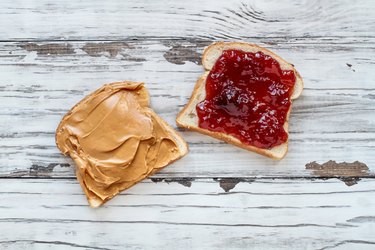
Although 65 percent of consumers reported eating more whole-grain products in 2017, refined, white bread is still a fast-selling, popular item. The fluffy texture, toasty flavor and smooth color pleases kids and adults.
However, you may wonder if you should worry about the nutritional value of bread, and whether it can really be part of a healthy diet. Calories in bread vary depending on the brand, recipe and serving size. Two slices of standard white bread, weighing about 56 grams (2 ounces), contain about 140 calories. You can easily fit white bread into a healthy meal plan.
Tip
White bread’s calorie count depends on the recipe, the size of your serving and the brand, but standard white bread contains about 70 calories per slice.
Video of the Day
White Bread Nutrition Label Information
In a standard 2 slices of white bread, you get 4 grams of protein and 1 gram of fat spread across those 140 calories. The bread nutrition label also reveals 28 grams of carbohydrates, 2 grams of fiber and 2 grams of sugar.
Video of the Day
Bread labels may list different calorie counts, and often that's due to serving size. For example, larger slices from an organic bread company that weigh 40 grams each contain 110 calories each.
Other nutrition in white bread includes 40 milligrams of calcium in the two slices, as well as 1.4 milligrams of iron, 270 milligrams of sodium and trace amounts of some B vitamins.
Reduced-calorie white breads are also available, if you're looking to manage your weight. These breads offer slightly-thinner slices, as well as modified ingredients. An example of reduced-calorie white bread has just 95 calories and 20 grams of carbohydrates per two-slice serving, and weighs 46 grams.
Whole Grain Bread Possibly Superior
Two slices of 100-percent whole-wheat bread may be nutritionally superior to white bread. The USDA Choose My Plate Dietary Guidelines for Americans recommends that at least half of the grains you eat daily be from whole-grain sources. Examples of whole-grains include whole wheat flour and oatmeal. Whole grains have the entire grain kernel intact, so they offer more fiber and nutrients.
The nutrition and fiber in whole grains offer a healthier digestive tract and protect you against diabetes, heart disease and some cancers, explains the Academy of Nutrition and Dietetics. White bread is considered a refined grain that's been milled, and as a result it is missing a lot of the nutrients that appear naturally in the grain kernel.
Read More: 19 High-Fiber Foods — Some May Surprise You!
In a two-slice serving of whole-wheat bread, you get the same 140 calories as with white bread, but 6 grams of protein and 24 grams of carbohydrates. Plus, you get twice the fiber, with 4 grams total. Go for a whole-grain oatmeal bread and you'll take in 200 calories, including 8 grams of protein, 36 grams of carbohydrates and 6 grams of fiber.
Increase Whole-Grain Bread Intake
Adding more whole grains to your diet, and the diet of your family, may assist your health and weight management efforts. But it's not always easy to get kids to eat whole-wheat or whole-grain bread. Research published in BMC Public Health in September 2014 found that presenting whole-wheat bread in fun shapes can increase kids' consumption of whole-wheat bread.
When selecting whole-grain bread, don't assume that just because it's brown, it's healthier. The American Heart Association notes that molasses or other ingredients can make a bread brown without any added whole grains. Look, instead, for the name "whole" or "whole-grain" as the first ingredient on the label.
If you're just not ready to make the switch away from white bread, get your whole grains in other forms. Have a bowl of oatmeal for breakfast. Choose brown rice instead of white for your next burrito or stir fry. Serve quinoa with your next bowl of chili, or as a side dish for grilled chicken.
- Academy of Nutrition and Dietetics: "What is a Whole Grain?"
- BMC Public Health: "Nudging Children Towards Whole Wheat Bread: A Field Experiment on the Influence of Fun Bread Roll Shape on Breakfast Consumption"
- Whole Grain Council: "Whole Grain Statistics"
- USDA Nutrient Database: "White Bread"
- USDA Nutrient Database: "Dave's Killer Bread, Organic White Bread"
- USDA Nutrient Database: "100% Whole Wheat Bread"
- USDA Nutrient Database: "White Bread, Reduced-Calorie"
- Choose My Plate: "All About the Grain Group"
- USDA Nutrient Database: "Whole Grain Oatmeal Bread"
- American Heart Association: "Whole Grains and Fiber"